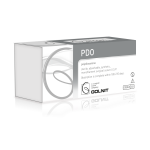DESCRIPTION
Coated PGA suture is a synthetic absorbable sterile surgical suture composed of polyglycolic acid. Coated PGA suture is prepared by coating the suture material with a mixture composed of polycaprolactone and calcium stearate. The copolymers used in this product have been found to be nonantigenic, nonpyrogenic and elicit only a mild tissue reaction during absorption. The sutures are available dyed and undyed (natural).
INDICATIONS
Coated PGA suture is indicated for use in general soft tissue approximation and/or ligation, including use in ophthalmic procedures, but not for use in cardiovascular and neurological tissues.
ACTIONS
Coated PGA suture elicits a minimal acute inflammatory reaction in tissue and ingrowth of fibrous connective tissue. Progressive loss of tensile strength and eventual absorption of coated PGA suture occurs by means of hydrolysis. Absorption begins as a loss of tensile strength followed by a loss of mass. PGA suture retains at least 65% of the initial strength after two weeks in-vivo. PGA has been found to be non-antigenic, non-pyrogenic and elicit only mild tissue reactivity during the absorption process. The absorption time for PGA suture is 60 to 90 days.
CONTRAINDICATIONS
This suture, being absorbable, should not be used where extended approximation of tissue is required.
WARNINGS
Users should be familiar with surgical procedures and techniques involving absorbable sutures before employing Coated PGA suture for wound closure, as risk of wound dehiscence may vary with the site of application and the suture material used. Physicians should consider the in vivo performance (under ACTIONS section) when selecting a suture. The use of this suture may be inappropriate in elderly, malnourished, or debilitated patients, or in patients suffering from conditions which may delay wound healing. As this is an absorbable suture material, the use of supplemental nonabsorbable sutures should be considered by the surgeon in the closure of the sites which may undergo expansion, stretching or distention, or which may require additional support. Do not resterilize. Discard opened packages and unused sutures.
As with any foreign body, prolonged contact of any suture with salt solutions, such as those found in the urinary or biliary tracts, may result in calculus formation. As an absorbable suture, Coated PGA suture may act transiently as a foreign body. Acceptable surgical practice should be followed for the management of contaminated or infected wounds.
PRECAUTIONS
Skin sutures which must remain in place longer than 7 days may cause localized irritation and should be snipped off or removed as indicated.
Under some circumstances, notably orthopaedic procedures, immobilization of joints by external support may be employed at the discretion of the surgeon.
Consideration should be taken in the use of absorbable sutures in tissues with poor blood supply as suture extrusion and delayed absorption may occur.
In handling this or any other suture material, care should be taken to avoid damage from handling. Avoid crushing or crimping damage due to application of surgical instruments such as forceps or needle holders. Coated PGA sutures, which are treated to enhance handling characteristics, require the accepted surgical technique of flat and square ties with additional throws as warranted by surgical circumstance and the experience of the surgeon.
Avoid prolonged exposure to elevated temperatures. To avoid damaging needle points and swage areas, grasp the needle in an area one-third (1/3) to one-half (1/2) of the distance from the swaged end to the point. Reshaping needles may cause them to lose strength and be less resistent to bending and breaking. Users should exercise caution when handling surgical needles to avoid inadvertent needle sticks. Discard used needles in “sharps” container.
ADVERSE REACTIONS
Adverse effects associated with the use of this device include wound dehiscence, failure to provide adequate wound support in closure of the sites where expansion, stretching, or distension occur, failure to provide adequate wound support in elderly, malnourished or debilitated patients or in patients suffering from conditions which may delay wound healing, infection, minimal acute inflammatory tissue reaction, localized irritation when skin sutures are left in place for greater than 7 days, suture extrusion and delayed absorption in tissue with poor blood supply, calculi formation in urinary and biliary tracts when prolonged contact with salt solutions such as urine and bile occurs, and transitory local irritation at the wound site. Broken needles may result in extended or additional surgeries or residual foreign bodies. Inadvertent needle sticks with contaminated surgical needles may result in the transmission of bloodborne pathogens.
STORAGE
We recommend that the suture shall be stored under a low temperature(less than 25℃) and low humidity (less than 60% RH). The storage in the dry chamber or the refrigerator is the best condition. Avoid the direct sunlight, high temperature and humidity.
HOW SUPPLIED
Coated PGA sutures are available sterile, as braided dyed (violet) and undyed (natural) strands in sizes, in a variety of lengths, with or without needles.




